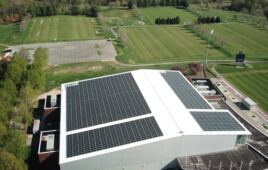U.S. electricity generators may be committing their customers and investors to as much as $1 trillion in future investment and fuel costs through 2030 as they rush to build new gas-fired power plants. Yet advances in renewable energy and distributed energy resources (DERs) offer lower rates and emissions-free energy while delivering all the grid reliability services that new power plants can, according to a new Rocky Mountain Institute report, “The Economics of Clean Energy Portfolios.”
According to the analysis, in addition to beating proposed gas-fired power plants on a levelized cost basis, “clean energy portfolios” of renewables and DERs will also increasingly threaten the profitability of existing gas plants.
The fleet of operating power plants that convert fossil fuels like coal and natural gas to electricity is aging, with over half of U.S. generation capacity more than 30 years old and expected to reach retirement age by 2030. Encouraged by advances in power plant technology and historically low natural gas prices, developers and power producers, including utilities and merchant generators, have announced plans to invest over $110 billion in new gas-fired power plants through 2025. Extrapolating this trend to 2030 suggests that over $500 billion will be required to replace all retiring power plants with new natural gas-fired capacity. This will lock in another $480 billion in fuel costs and 5 billion tons of carbon dioxide (CO2) emissions through 2030, and up to 16 billion tons of emissions through 2050—about half of total global emissions in 2017, according to the International Energy Agency.
Amid this “rush to gas,” renewable energy technologies, including wind and solar, and DERs, such as batteries, have fallen precipitously in price in the past 10 years. And developer and grid- operator experience with these resources has demonstrated their ability to provide all of the grid services typically provided by fossil-fueled power plants. Together, these technologies can be combined into clean portfolios of energy resources that can provide the same services as power plants, often at net cost savings, according to “The Economics of Clean Energy Portfolios” report.
“Renewables and DERs are outcompeting and beginning to capture market share from natural gas-fired generation in many parts of the country, including both peaking capacity as well as higher-efficiency, combined-cycle plants,” Mark Dyson, a principal at RMI and an author of the report, said. “The consequences of continuing a business-as-usual approach—building new gas generation when clean energy technologies are increasingly winning the day—promises to negatively impact customers, investors and the environment through higher energy costs, the risk of stranded assets and greater carbon and air emissions.”
The report analyzes four natural gas-fired power plants currently proposed for construction across the US and compares them with optimized, region-specific clean portfolios of renewable energy and DERs that can provide the same services. The analysis includes two announced combined-cycle gas turbine power plants, planned for high capacity-factor operation, and two announced combustion-turbine power plants, planned for peak-hour operation. In three of the four cases, an optimized clean energy portfolio would cost 8–60% less than the announced power plant. In only one case the analysis finds the net cost of the optimized clean energy portfolio is slightly (~6%) greater than the proposed power plant. Factoring in expected further cost reductions in distributed solar and/or a $7.50/ton price on CO2 emissions, all four cases show that an optimized clean energy portfolio is more cost-effective and lower in risk than the proposed gas plant.
To access a copy of the report, see http://www.rmi.org/insights/reports/economics-clean-energy-portfolios.
News item from the Rocky Mountain Institute




Tell Us What You Think!